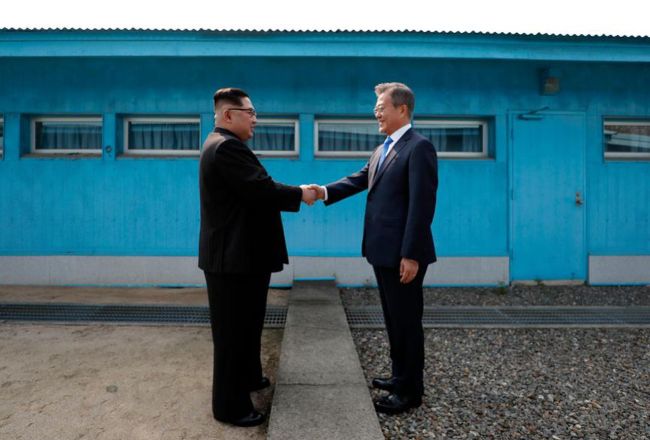Stalled nuclear talks put brakes on implementation of inter-Korean agreement
By Park Han-naPublished : April 24, 2019 - 20:13
About a year ago, President Moon Jae-in and North Korean leader Kim Jong-un held their historic first summit at the border village of Panmunjom, which led to a rapid thaw in inter-Korean relations.
To mark the first anniversary of the Panmunjom Declaration that the two Koreas signed at the April 27 inter-Korean summit, the South will hold a ceremony Saturday at the recently demilitarized Panmunjom, though Pyongyang’s lukewarm attitude toward Seoul in recent months indicates a slim chance of the North’s participation in the event.
To mark the first anniversary of the Panmunjom Declaration that the two Koreas signed at the April 27 inter-Korean summit, the South will hold a ceremony Saturday at the recently demilitarized Panmunjom, though Pyongyang’s lukewarm attitude toward Seoul in recent months indicates a slim chance of the North’s participation in the event.

The Moon administration believes that inter-Korean reconciliation through implementation of the agreement is crucial in achieving progress in nuclear negotiations. However, the breakdown of a summit between US President Donald Trump and Kim in Vietnam in February is taking a toll on the two Koreas’ moving forward, experts said.
Following the US-North Korea summit, Pyongyang has stepped up pressure on Seoul to persuade the US to lift sanctions on inter-Korean economic projects, which would provide the cash-strapped regime with much needed foreign currency.
On March 22, North Korea abruptly withdrew its entire staff from a liaison office with the South in Kaesong, thought they returned four days later. High-level talks have not taken place since October last year.
Results in halting hostile military acts
The Panmunjom Declaration had three major points: improving inter-Korean relations, easing military tensions and establishing a peace regime on the peninsula.
Among them, cessation of military actions has outpaced other agreements in yielding tangible outcomes, according to Korea National Defense University professor Moon Jang-ryul.
“South and North Korea were in desperate need for peace. In particular, they were able to push ahead (the easing of military tensions) because it doesn’t involve sanctions imposed on North Korea,” he said.
The two Koreas have removed a total of 22 guard posts inside the heavily fortified Demilitarized Zone. Broadcasting through loudspeakers and the distribution of leaflets in areas along the Military Demarcation Line had been immediately suspended as pledged by the two leaders.
Artillery drills by the two Koreas have been prohibited within 5 kilometers from the MDL, while live-fire drills involving fixed-wing aircraft and air-to-ground guided weapons are barred in the no-fly area.
Meanwhile, discussions on turning areas around the Northern Limit Line in the West Sea into a maritime peace zone have made little headway so far.
Progress in peace regime slows
There has not been much progress made on the agreement to pursue trilateral meetings involving the two Koreas and the US, or quadrilateral meetings involving the two Koreas, the US and China “with a view to declaring an end to the Korean War to turn the armistice into a peace treaty.”
After the collapse of the Trump-Kim talk in Hanoi, the two countries have struggled to narrow the gap between the North’s denuclearization steps and reciprocal measures from the US.
On April 12, Kim said he is open to a third summit with Trump, giving Washington until the year’s end to offer mutually acceptable terms for Pyongyang to commit to giving up its nuclear arsenals. But Trump has said, “I don’t want it to move fast.”
To break the deadlock, President Moon on April 15 called for a fourth summit with Kim but the North has yet to respond to the proposal.
Analysts here say the South Korean government should seek consultations with neighboring countries to create denuclearization measures that could bring both the North and the US back to the negotiating table.
“I don’t understand why the government did not pursue meeting with China, Russia and Japan. To play a mediator role, we should come up with measures containing real content,” said Kim Joon-hyung, a professor at South Korea’s Handong Global University.
Relations at standstill despite engagement
The development of relations with the North under the Panmunjom Declaration has been fulfilled in many aspects.
The number of South Koreans visiting the North and vice versa increased sharply to 7,498 in 2018 from 115 in 2017, according to government data. A project to connect inter-Korean railways, a forestry project and various sports events contributed to the boost in personnel exchange.
In accordance with the declaration, high-level talks were held in June and August last year to review the implementation of the agreement. Moon and Kim met once again in Pyongyang in September and signed the Pyongyang Joint Declaration of September 2018, which provided more details and the scope of confidence-building measures agreed to in the earlier Panmunjom Declaration.
The two Koreas held reunions of families separated by the Korean War from Aug. 20-26 at the Kumgangsan resort. Currently, Seoul is pushing for video reunions for war-torn families.
The Unification Ministry has started renovation of 13 video conference centers nationwide and secured sanction exemptions from the UN Security Council to send equipment needed for the operation of a reunion center in Pyongyang.
The opening of an inter-Korean liaison office in Kaesong in September last year has been regarded as a significant milestone in inter-Korean relations, but use of the communication channel has been thrown into doubt.
Following the Hanoi summit, North Korea skipped the weekly meeting of co-chiefs of the liaison office for eight consecutive weeks.
Cheong Seong-chang, a senior researcher at the Sejong Institute, said inter-Korean relations remain almost the same as a year ago despite projects the two sides have carried out since the Panmunjom Declaration.
“It is clear that there is a limit to inter-Korean projects in the absence of progress in denuclearization talks,” he said.
By Park Han-na
(hnpark@heraldcorp.com)








![[Today’s K-pop] BTS pop-up event to come to Seoul](http://res.heraldm.com/phpwas/restmb_idxmake.php?idx=644&simg=/content/image/2024/04/17/20240417050734_0.jpg&u=)
![[Graphic News] More Koreans say they plan long-distance trips this year](http://res.heraldm.com/phpwas/restmb_idxmake.php?idx=644&simg=/content/image/2024/04/17/20240417050828_0.gif&u=)







![[KH Explains] Hyundai's full hybrid edge to pay off amid slow transition to pure EVs](http://res.heraldm.com/phpwas/restmb_idxmake.php?idx=652&simg=/content/image/2024/04/18/20240418050645_0.jpg&u=20240419100350)

